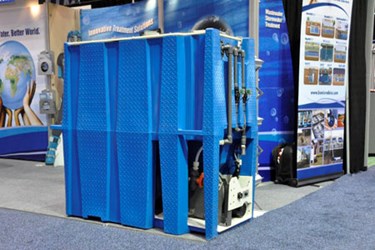Decentralized Wastewater Treatment Uses Energy Wisely

Bob Rebori, President of Bio-Microbics, discusses the challenges and benefits of using decentralized wastewater treatment for commercial applications.
The following is an excerpt from a Q&A with Water Online Radio. Click on the Radio Player above to hear the full interview.
Water Online Radio: Bob, in your introductory comments, you mentioned centralized versus decentralized. What are the pros and cons of each?
Bob: It is not so much about pros and cons. I think lately, because of the technologies of both big flow and small flow, they are using them in combination, more like distributed systems, but there are two major differences between decentralized treatment and centralized treatment.
The first is in decentralized treatment where you rarely have a full-time trained operator. In fact, you may only have two visits a year to a particular installation even if it is a commercial installation.
So the equipment needs to be really simple, just to operate itself. The other major factor is that on a central collection system, the wastewater is mixed from many different sources; households, hotels, shopping malls, restaurants, you name it.
In a decentralized application, you have to size for the wastewater specific to the source. So a laundromat is going to be different than say a hotel which is going to be different than say a shopping mall or a restaurant. Each of those is unique.
Water Online Radio: Well, talking about decentralized treatment, what are the forces that are driving municipalities to want to look at them? Talk about some of the issues that make these municipalities really look at a decentralized solution carefully.
Bob: In addition to aging infrastructure, overloaded treatment plants and large amounts of clogging, they are starting to look at technologies for pre-treatment because with the wastewater plants, the central plants can be biologically overloaded and if you do pre-treatment at the source, you can avoid this. A good explanation of that would be a restaurant which is very high strength wastewater. You cannot down the strength and, therefore, you can take the biological load off the central collection plant. So that is one way.
The other is to use decentralized equipment on outlying areas where it is very costly to lay sewer pipe with the intention of tying it into a more central collection and maintenance system.
Water Online Radio: Bob, regulations loom large for everybody in the water treatment business. Are there any things in particular that make it more challenging for smaller flows in the decentralized system?
Bob: Absolutely. In the decentralized industry, the regulations are extremely fragmented so you must go state by state, country by country to get your approvals and in many states in our nation, it is county by county and even if the states insist that they have a strong state code, the county sanitarians have a lot of authority to impose their own regulations. So it is very fractured.
We have an enormous amount of third party testing and applications for many different types of products whereas in the marine industry, you just need the International Maritime Organization certification and the US Coast Guard and maybe a few others like Canadian Great Lakes and so forth and so on.
Water Online Radio: You mentioned state and county regulations, what about municipalities? Are they under the same rule?
Bob: Generally, not. Generally, the municipalities are governed by the DEP at the federal and state level, and at the decentralized level, the regulations may come from the DEP at the state level but often they come through the health department and they are often administrated county by county with different individuals.
Water Online Radio: Bob, Bio-Microbics also manufactures stormwater treatment equipment. Is that a whole lot different than what we have been talking about and are regulations any different?
Bob: It is different. With stormwater treatment, you want to capture and hold that first flush. It is really important when the first rain comes. The roads are slickest during that first portion of the rain with the oil debris, the sand, the silt, the trash; that all goes into the culverts.
You want to capture that stuff into your treatment system, and you want to do it in such a way that it is easy to maintain with no power because it is a thunderstorm or a rain event so it is a wet event.
The testing regulations are different. In wastewater, they like to measure for TSS removal. They do the same in stormwater but it is a different TSS. It is essentially sand and silt and debris of that nature, and it is measured more like you would measure grit removal on headwork.
Water Online Radio: Bob, you just won a very prestigious award not too long ago. Tell us the story behind that.
Bob: There is a vacuum in the decentralized industry where you have either large complicated equipment from central manufacturers, or central treatment equipment where you have smaller systems, and people do not want to use a whole pile of smaller systems for larger flows. So we came up with a concept called MyFAST which is an engineered system of modules that bolt together and act as one model of system for the in-between flows.
Also what we did is cherry pick the better facets of large-flow and small-flow equipment and meld them together, and we are able to do that because of the experience of our staff. We have both big-flow and small-flow experienced people that have spent the most part of their lifetime in the industry, and that is how we put it all together. It has been a very popular product.
Click on the Radio Player above to hear the full interview.
